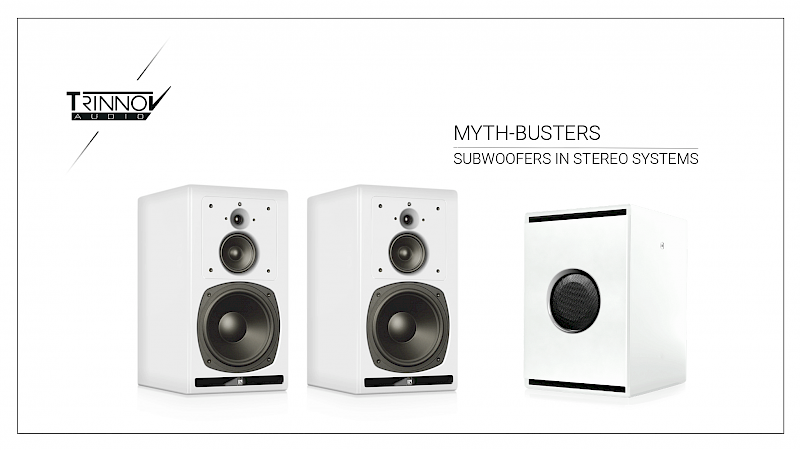
There are many myths that have been perpetuated in the world of high-end audio. We have seen a remarkable range of schemes seemingly designed mainly to part you from your hard-earned cash: little rounds of exotic hardwood that would miraculously alter the acoustics of your room for the better; magic green markers that made your CDs sound better; even little flaps of leather you wear as an extension of sorts to your outer ears to “enhance” your hearing.
Can these things alter the sound you hear? Maybe, in some cases. Can they do so in scientifically reproducible ways that are consistently positive? Not so much.
One such myth is that there is no way to add subwoofers to a good stereo system without making matters worse. However, this is another example of something that is simply not true. Though, in this case, at least one can understand why people have that impression.
Let’s take a closer look.
Benefits of Subwoofers in Stereo
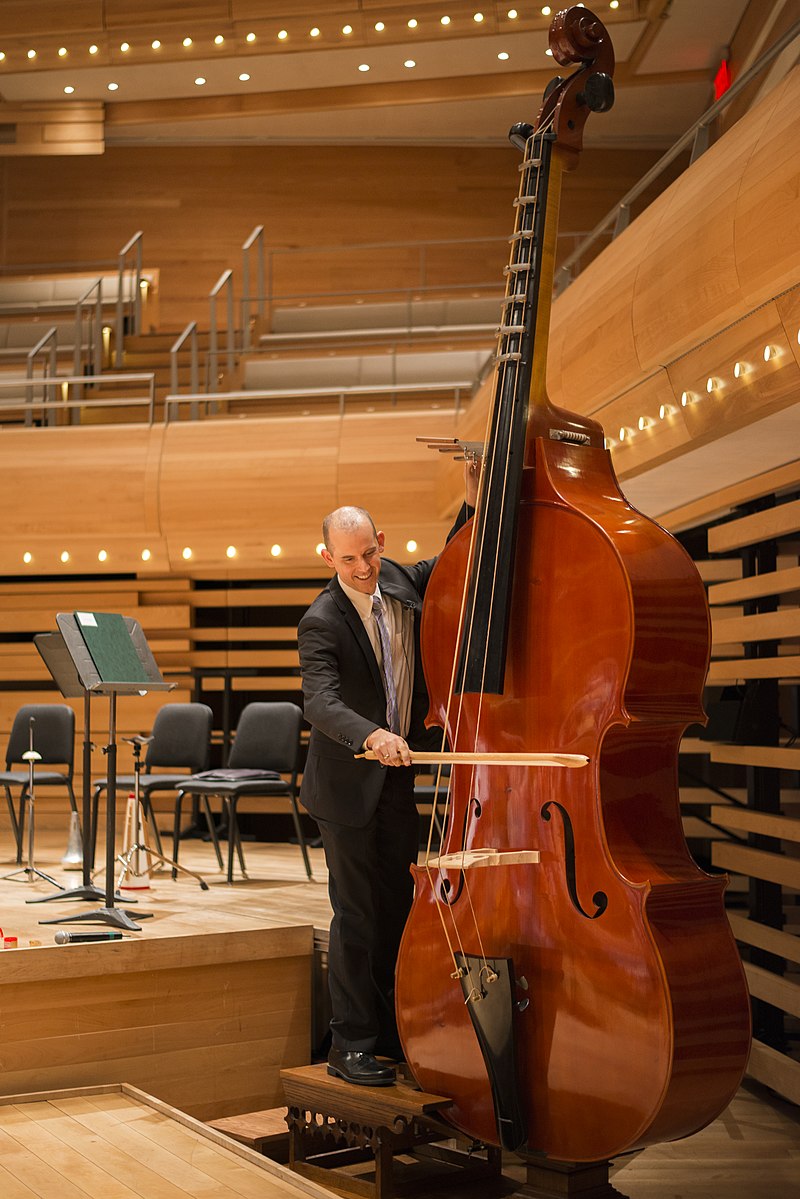
Have you heard of this instrument? It's an Octobass
Deeper Bass
A well-designed subwoofer will almost certainly reproduce deeper bass than most “full range” stereo speakers. Of course, you can pick and choose the odd example where this may not be true – but what would be the point of even considering such oddball cases?
A well-designed subwoofer can provide bass you feel as well as bass you hear. The haptic effect – feeling as well as hearing – enhances the experience of music, especially large-scale music. It might be a symphony orchestra’s tympani and bass drums, or a band rocking out to your favorite song. Either way, engaging more senses is a Good Thing.
Enhance Sense of Scale
Along with this bass extension comes an improved sense of the sheer scale of the performance space. The ability to reproduce the extremely low frequencies that develop easily in larger venues subjectively opens up the confines of your living room and makes it sound like you are in a much larger space.

Saint Maurice Cathedral, Mirepoix
There are, perhaps, multiple reasons for this effect. But think about sacred music being performed in a cathedral: there is an effortless sense of ease to the lowest notes of the pipe organ, and such spaces exhibit subharmonics that are created by the interactions of sound waves within the cavernous volume.
If you were led, blindfolded, into such a space, you would be able to sense that you were in an extremely large, indoor space. Part of this lies in the fact that the bordering-on-infrasonic information in the cathedral is fundamentally different than what you hear in a normal living room, or in open air.
Subwoofers with great extension and accuracy can recreate this perception of huge space in your home.
Improved Dynamic Range / Lower Distortion
Of course, when you relieve your main speakers from doing the deepest bass, the woofers of your main speakers do not have to work as hard; similarly, the associated amplifiers also have an easier task. Less strain means cleaner sound with the remainder of what they are asked to do, and they can play louder since the extreme excursion required by the deepest bass is no longer being asked of them.
After all, by adding subwoofers to your system, you are adding both power and drivers that can move more air – it should be able to play louder before it starts sounding at all strained. Adding subs allows your system to play both more loudly when required and more clearly at any level, assuming the subs are integrated properly.
Separation of Powers
This benefit is less obvious, but offers perhaps the most significant improvement when you have both excellent subs and main speakers in your stereo system.
The placement of your main speakers will be driven, in most cases, by what is required to get the best-possible stereo imaging. There are different ways of optimizing imaging but, in the end, a lot of it comes down to a bit of trial and error. Spread them too far apart, and a hole opens up in the middle. Too close together and you get a small, unsatisfying image. Likewise with toe-in and other placement details.
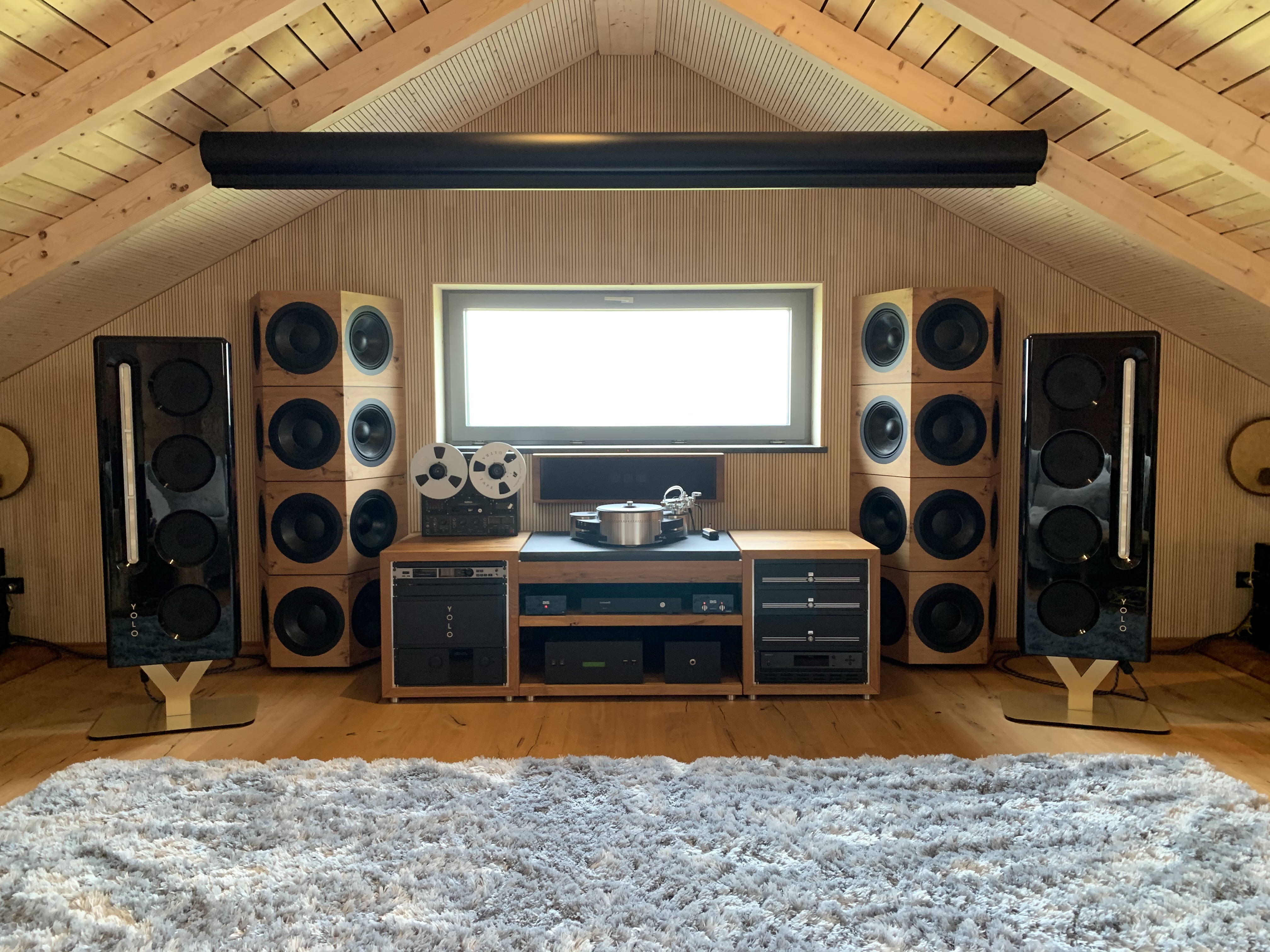
Bohne Audio System with dedicated bass units
Here is the problem: the location that is best for stereo imaging is (incredibly) unlikely to be where those speakers also reproduce the best bass. By separating the extremely room-specific optimal location for bass from the best location for imaging, you can have the best of both worlds: fantastic, holographic imaging and soundstaging with deep bass performance that will give you goosebumps on demand.
Pitfalls of Adding Subs to Stereo
There is really only one (aside from buying bad products): integration.
Far too often, subwoofers are added almost as an afterthought. People have heard that they are omnidirectional (usually true) and that they can be placed anywhere (never true if you care about the result). It should not be surprising to any audiophile who has painstakingly fine-tuned the placement of their speakers for the best performance that something similar might be required for subwoofer placement as well. Yet, the myth lives on…
Making the handoff from main speakers to subwoofers as seamless as possible almost always involves a flexible, active crossover. These should not be confused with the built-in low-pass filters included in many subs. You need to control both sides of the handoff in terms of
- Level
- Delay
- Crossover Slopes
- Phase (Including but not limited to polarity)

Active Crossovers can be used as an alternative to Bass Management
Fortunately, modern surround processors almost always have at least the most basic of these controls, with the best ones mastering them all; there are even a few modern stereo preamps with these advanced capabilities, both from Trinnov and a small number of other companies.
Let’s look at these four items.
The level seems simple enough: make sure that all the speakers are playing at the same volume when they are supposed to be playing at the same volume.
While this is relatively straightforward, it is not exactly trivial. Most SPL meters are designed to be accurate with bandwidth-limited pink noise. The relevant bandwidth of subwoofers and mains are almost completely different. There may be some overlap between them, but the whole point is to bring something new to the system that wasn’t there before.
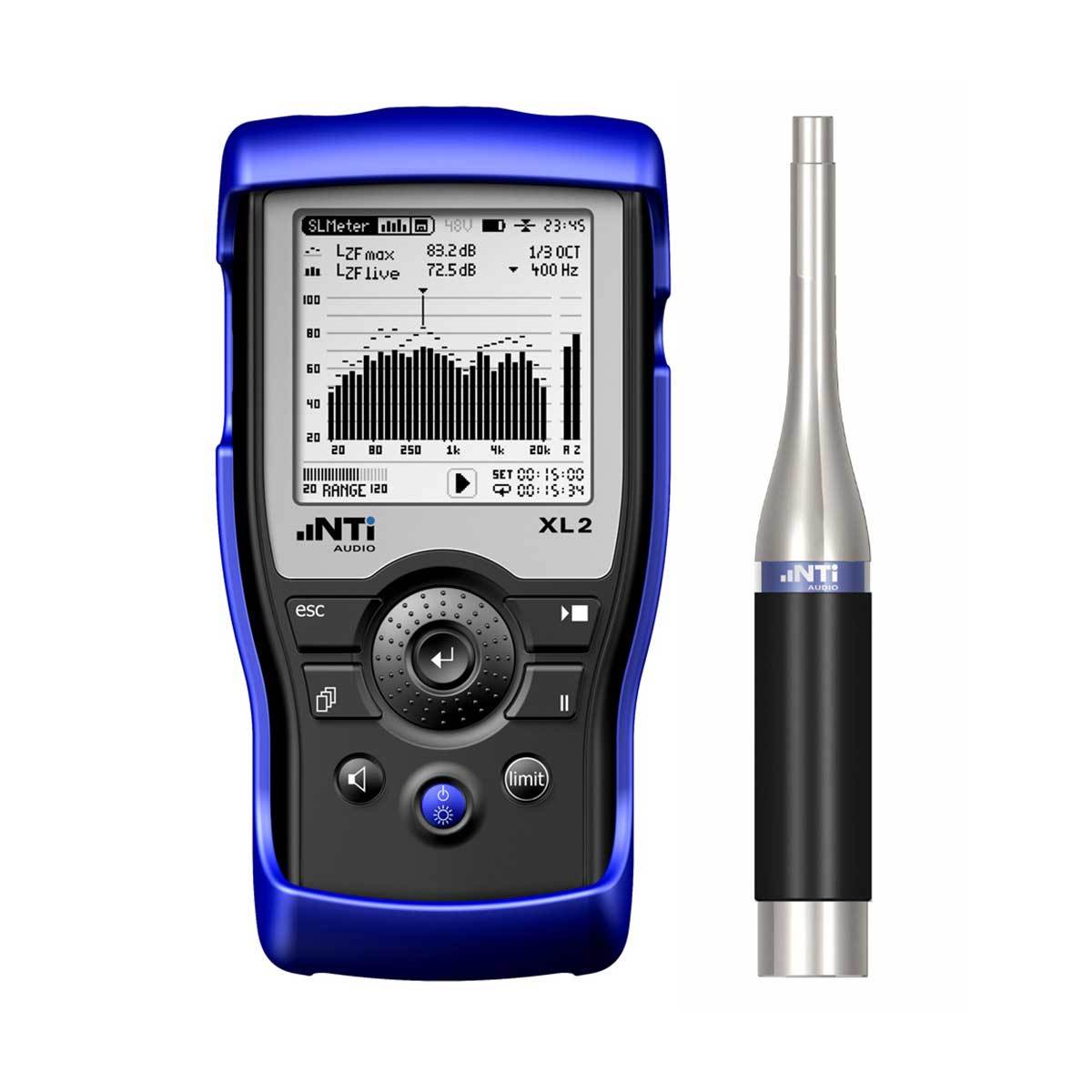
Sound Level Meter (NTI)
You need to be careful that your measurement microphone is accurately calibrated over an extremely wide range and the measurement system must be able to calculate the level based on what the respective speakers will actually be asked to do (rather than what they are capable of doing).
Having said that, a competently designed product should be able to get you very close. You always have the option of fine-tuning it by ear for a seamless handoff.
Delay also seems pretty straightforward, though it really is not.
Once upon a time, you could approximate things with a tape measure and a rule of thumb like “one foot equals about 1ms.” This is no longer true in a world of both subs and main speakers that use DSP in their designs. The signal processing requires a certain amount of time, or “latency,” in order to do its thing. The result is to make the speaker seem as though it was farther away than would be indicated by a tape measure – the sound simply takes longer to get through the box, into the air, and across the room to the mic.
The only way to get this right today, with so much DSP in so many products, is by acoustic measurement in the room. “Distance” means nothing. The goal is for all sounds to arrive at your ear together, at the correct time, regardless of where the speakers might be, or what DSP may be in use.
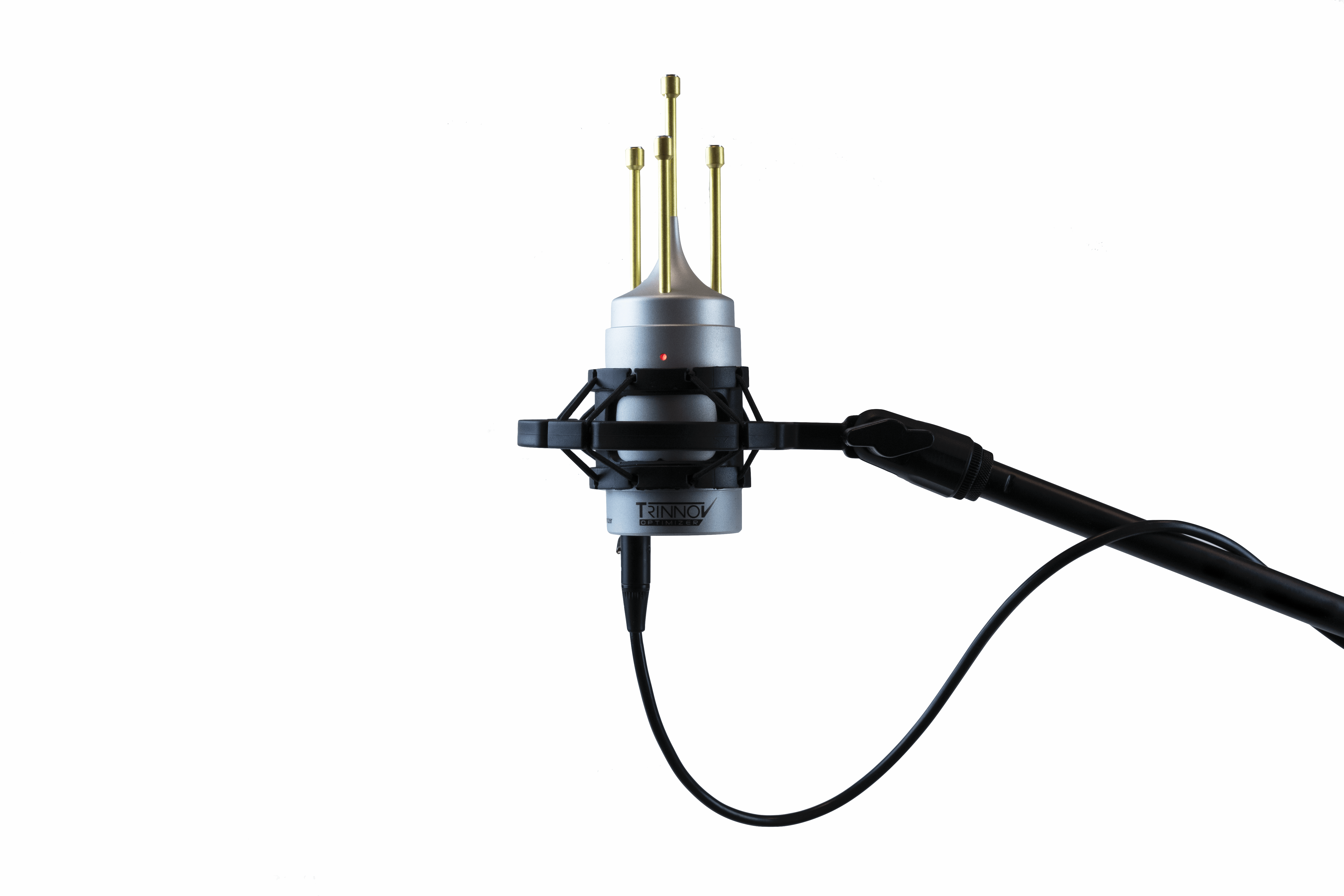
Trinnov 3D Measurement Microphone
Accurately measuring the requisite delay for any subwoofers is an area where we have found significant differences between different systems.
By definition, low frequencies change more slowly than high frequencies. A single cycle at 100 Hz is 10ms long (which translates to about ten feet or 3m) whereas a 10 kHz wave lasts only 0.1ms. It is inevitably more difficult to accurately identify the exact moment when that slowly changing bass wave peaks, before it starts to recede. In this, it is like finding the exact summit of a long, rounded hill, as opposed to the sharp peak of the Paramount logo.
(BTW, the Optimizer is quite good at doing this time alignment, much better than most.)
Crossover Slopes matter for several reasons. The first and most important thing to realize is that the electronic slopes should not be the focus of your attention. The acoustic slopes of the sound in your room are what really matter.
Tomlinson Holman of THX fame had this right thirty years ago: while most subwoofers would be reasonably flat well up into the midbass and higher if given the opportunity, most main speakers will be rolling off at the bottom of their range, where you might like to add a sub or two. This acoustic asymmetry requires an offsetting electronic asymmetry.
In the case of an acoustic suspension (sealed box) system, the low-frequency roll-off is at a rate of 12 dB/octave. If you decide to do the handoff at that corner frequency, you need to add the 12 dB/octave acoustic attenuation to whatever your active crossover is doing in order to get an acoustically symmetrical transition.
In this example, if your main speakers are sealed boxes with an f3 of 40 Hz, you might try a 4th-order (24 dB/octave) Linkwitz-Riley filter on the subwoofer side of the crossover and a 2nd-order (12 dB/octave) Linkwitz-Riley filter on the main speaker side; the electronic 12 dB/octave slope with combine with the natural 12 dB/octave slope of the speaker to yield a nice, symmetrical 24/dB octave handoff at 40 Hz. This approach will help minimize any unwanted bumps or dips around the crossover region.
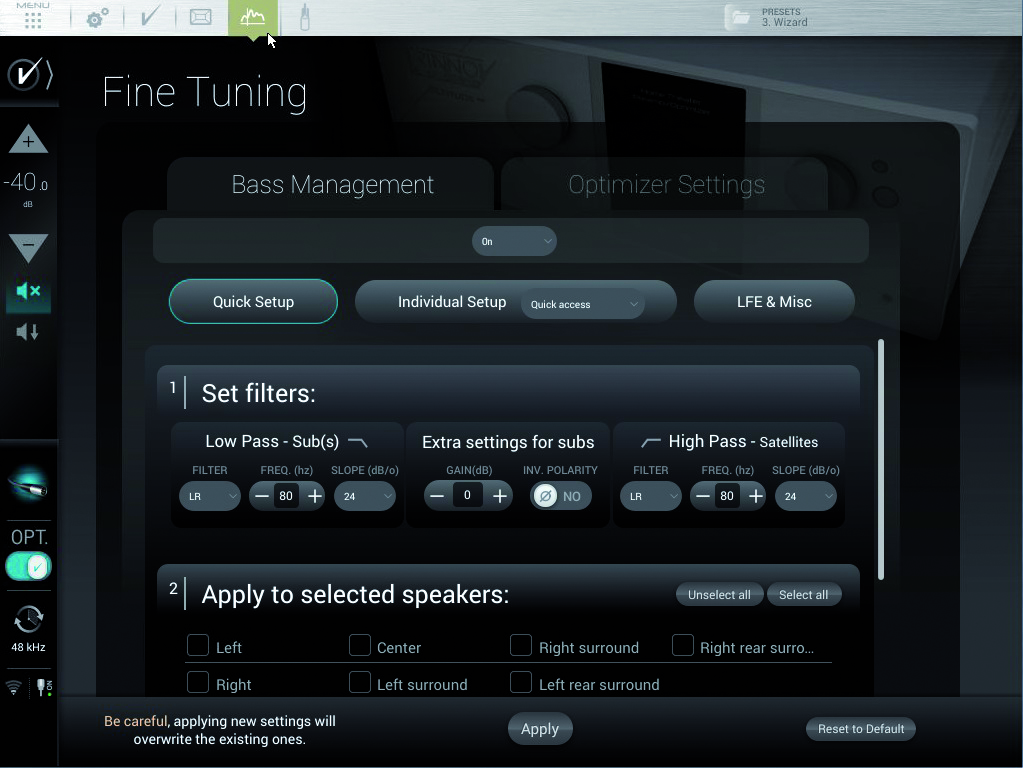
Trinnov Bass Management on the Altitude Platform
Alternatively, you may have speakers that overlap quite a lot in terms of the frequencies they cover well. In that case, a symmetrical electronic filter with an octave or more of overlap on both sides might be a better choice.
Of course, there are almost endless permutations. For that reason, we support a rather large number of filter topologies to give you the flexibility you may require, including Bessel, Butterworth, and Linkwitz-Riley filter topologies at a wide variety of slopes (1st- to 8th-order), in 1 Hz increments in terms of their f3 (corner) frequencies.
Phase: Many people conflate “Phase” with Polarity. They are related but not the same. The latter is either 0° (unaltered) or 180° (reversed, as can be done accidentally by mis-wiring your speakers backward). “Phase” refers to any timing change at all, whether by a single degree, 90°, or anything else you might name.
Phase is especially important around the crossover region since errors here can cause the handoff to be less smooth than desired. It is also complicated by the fact that every filter used in a crossover introduces its own phase changes – they are part and parcel of the process by which some frequencies are attenuated while others pass through unchanged. The same is true for the speakers themselves – every rolloff is accompanied by a commensurate change in phase.
(Another HiFi Myth: “Equalization is bad because it introduces phase changes.” In fact, to the degree that EQ flattens the response of speakers, it is also improving the phase performance of the speakers.)
Let’s take a hypothetical example: in the aforementioned 40 Hz system, we do everything right on paper, attempting to get a nice, symmetrical 24 dB/oct. acoustic crossover in the room. However, for whatever reason, the subwoofer is -90° in phase at 40 Hz and the main speaker is +90° at 40 Hz. This means they are 180° apart from each other at 40 Hz and will cancel each other out. This leads to a sharp dip in the response that could, in fact, be fixed by flipping the polarity of one or the other (not both).
But what do you do if the main speaker is behaving itself fairly well and is only +10° at 40 Hz, but the subwoofer is still -90°? Changing the polarity will make it sound different, but neither one will be correct. They will simply be different.
Ideally, the rate at which phase is changing as a function of frequency for both speakers could be matched fairly closely throughout the relevant crossover region. Normally, accomplishing this efficiently requires fairly sophisticated measurements and some experimentation with a variety of filters to see which provides the best match between the upper and lower halves of the crossover.
Trinnov's Solutions
All Trinnov preamplifiers, whether for stereo or multichannel, or for the studio or the home, include powerful active crossover capabilities that – among other things – facilitate the proper integration of one or more subwoofers into your system.
The Altitude platform supports up to four-way active crossovers, as do our commercial cinema products and our higher-channel-count studio gear. The ST2-HiFi and Amethyst offer much the same capabilities but with the limitation of supporting up to a two-way active crossover. As such, they can do either active or passive 2.0, or they can support 2.1 or 2.2 systems (the latter with either mono or stereo subs).
Is Everything Automatic?
Sorry, no. There are some good reasons why you would want a human being (yourself) involved in the subwoofer integration and fine-tuning process.
Let’s take a simple example: you have a pair of mini-monitors that you love – they image spectacularly well, they are unobtrusive in your room, but they lack deep bass. An automated test at, say, 75 dB SPL might determine that they can handle frequencies down to 50 Hz.
However, you know that when you get rowdy and play things at a volume of 95 dB SPL, the extra 20 dB of volume beyond the test signal’s level would cause those poor little woofers to strain. They might be able to play 50 Hz at 75 dB SPL, but that extra 20 dB represents 100 times as much power.
You might be better served crossing them over at 75-80 Hz in order to free up their available excursion for midbass and higher frequencies. This has the effect of increasing your available dynamic range by diverting more of the load to your new sub(s).
So, as you can see, depending on an automated system to know the real-world limits of your system at higher SPLs is perhaps not the best idea.
Instead, we make it incredibly simple to try several different crossovers and to quickly and easily compare them. Our measurements show what your speakers can do in your room, without any crossovers; this allows you to better decide what you want to ask them to do when crossed over and bass-managed.
A few minutes of experimentation can both be fun and quite rewarding.

